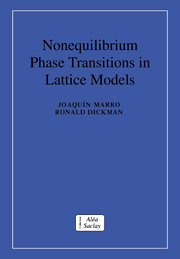3 - Driven lattice gases: theory
Published online by Cambridge University Press: 29 September 2009
Summary
Chapter 2 contains an essentially phenomenological description of the DLG. We now turn to theoretical descriptions, a series of mean-field approximations, which yield analytical solutions for arbitrary values of the driving field E and the jump ratio Γ. We find that mean-field approximations are more reliable in the present context than in equilibrium. For example, a DLG model exhibits a classical critical point for Γ, E → ∞ (§3.4), and simulations provide some indication of crossover towards mean-field behavior with increasing Γ (§2.3). On the other hand, the methods developed here can be used to treat the entire range of interest: attractive or repulsive interactions, and any choice of rate as well as any E and Γ value. As illustrated in subsequent chapters, these methods may be generalized to many other problems.
The present chapter is organized as follows. §3.1 contains a description of the method and of the approximations involved. The one-dimensional case is solved in §3.2 for arbitrary values of n, E, and Γ, and for various rates. A hydrodynamic-like equation and transport coefficients are derived in §3.3. In §§3.4–3.6 we deal with two- (and, eventually, three-) dimensional systems. In particular, the limiting case for Γ, E → ∞ studied in van Beijeren & Schulman (1984) and in Krug et al. (1986) is generalized in §3.4 by combining the one-dimensional solution of §3.2 with an Ω-expansion, to obtain explicit equations for finite fields and for the two limits Γ → ∞ and Γ → 0. A two-dimensional model is solved in §3.5.
- Type
- Chapter
- Information
- Nonequilibrium Phase Transitions in Lattice Models , pp. 61 - 99Publisher: Cambridge University PressPrint publication year: 1999



